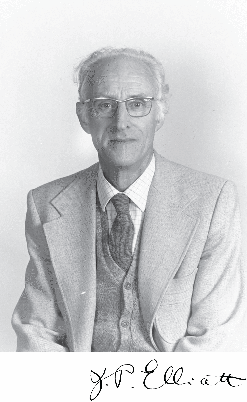James Philip Elliott facts for kids
Quick facts for kids
James Philip Elliott
|
|
|---|---|
 |
|
| Born | 27 July 1929 Gosport |
| Died | 21 October 2008 |
| Alma mater | |
| Awards |
|
| Academic career | |
| Institutions | |
| Doctoral advisor | Hermann Arthur Jahn |
James Philip "Phil" Elliott (born July 27, 1929, in Gosport; died October 21, 2008, in Lewes) was a brilliant British scientist. He was a theoretical nuclear physicist. This means he studied the tiny parts inside atoms and how they work.
Contents
About Phil Elliott
Elliott studied physics at the University of Southampton. He earned his doctorate in theoretical nuclear physics there. His teacher was Hermann Arthur Jahn.
From 1951, he worked at the Atomic Energy Research Establishment in Harwell, Oxfordshire. He first studied how neutrons move in nuclear reactors. Later, he focused on the structure of atomic nuclei.
Key Discoveries
In the 1950s, Elliott worked with Brian Flowers. They did important research that helped connect two big ideas in nuclear physics: the Nuclear shell model and collective models. These models help explain how atomic nuclei are built. They especially looked at light nuclei, like those in oxygen and fluorine.
Elliott spent a year at the University of Rochester. In 1962, he became a professor at the University of Sussex. He retired in 1994 but kept working on science until he passed away. From 1979 to 1984, he was the head of the Faculty of Mathematics and Science.
Group Theory and Nuclear Structure
Elliott was a leader in using group theory in nuclear physics. Group theory is a type of math that helps understand patterns and symmetries. In 1958, he used the SU(3) group to study nuclear structure. He also wrote a book about how to use group theory in physics.
At the University of Sussex, he helped create special calculations for nuclear structure. These calculations, called "Sussex Matrix Elements," helped scientists understand how particles inside a nucleus interact. In the 1980s, he explored the interacting boson model. This model helps explain how atomic nuclei behave.
Personal Life
Phil Elliott was married to Mavis Avery. They had a son and a daughter. Outside of his scientific work, he enjoyed opera and gardening.
Awards and Recognition
Elliott was recognized for his important contributions to science.
- In 1980, he was chosen to be a member of the Royal Society. This is a very old and respected scientific group.
- In 1994, he received the Ernest Rutherford Medal and Prize from the Institute of Physics.
- In 2002, he was awarded the Lise Meitner Prize by the European Physical Society.

